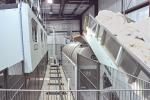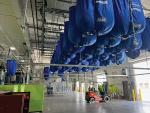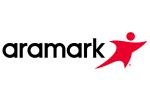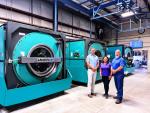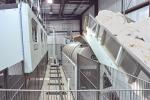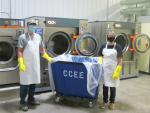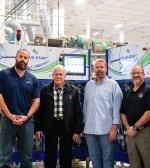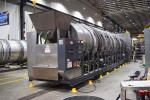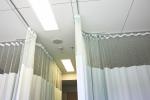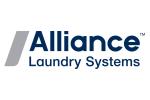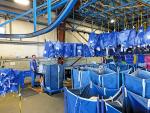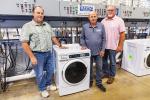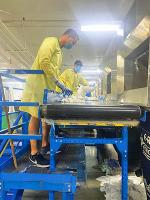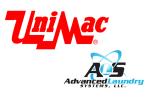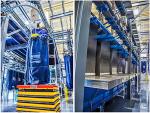CHICAGO — Laundry and linen services continue to learn from and deal with events that have taken place over the past few years.
That includes on-premises laundry (OPL) operations.
American Laundry News reached out to several professionals to find out what’s happening on the OPL side of the industry and communicated with three on-premises laundry representatives.
On the hotel OPL side, John Smith is the chief engineer of the Embassy Suites laundry in Indianapolis.
“It’s a 360-room property,” says Smith. “Every room’s a suite because it’s an Embassy, and we do all the laundry in-house. We don’t send anything out.”
On the healthcare side, Gustavo Guzman is laundry operation director for Community Memorial Healthcare in Ventura, California, a nonprofit, independent health system. Its on-premises laundry has been in operation for more than 55 years.
“We process an average of 2.6 million pounds annually,” shares Guzman. “Our product mix consists of core bed linens, scrubs for doctors and nurses, and EVS towels and mops.
“Our washroom consists of three Milnor 450-pound washers, two CLM 400-pound steam dryers, and two Chicago roll ironer, feeder and folders. We process six days per week and use an exchange cart program to service the CMH system.”
Finally, Eric Meyers brings a consultant’s view to the state of OPL operations. He owns laundromats and is the general manager for the North America trade/OPL segment for Alliance Laundry Systems.
OPL OPERATIONS TODAY, TOMORROW
Today, many hotels are seeing increased room nights, so those properties with OPLs are processing more linens and towels.
Smith says that so far in 2023, Embassy Suites has been selling out more nights, and the OPL is using its equipment more.
“We did have a few companies that hit us up, wanting us to send our linen out, to outsource it to get it done,” he shares. “We ran the numbers, and it just didn’t make sense for us to do that.
“We were set on making sure that we could do our linen in-house so we could control the quality.”
The issue that remains, according to Smith, is labor.
“I think it would be the same in OPL as it would be outsourced, getting people to do the laundry,” he points out. “Whether you’re doing that at an OPL level or you’re sending it out, they have to hire people to do that.
“So, staffing does seem to be the No. 1 issue right now. We can get equipment. We can get soap. We can get linen. It’s the staffing issue.”
The greatest change Smith has seen in his OPL as a result of the past few years is the higher cost of doing laundry.
“The amount that it costs you to do linen, period, whether you do it in-house or send it out, has drastically increased, and I think most of that is due to labor increases,” he says.
“We’re starting to see an increase in retooling of hotel OPL facilities,” shares Meyers. “But when they do, they retool because labor continues to be a challenge.
“If they have the room in their facility, they are upsizing and upgrading the size of the equipment so they can do more laundry in a shorter period of time to save them a ton on labor. Automate the process to a machine rather than manual labor.
“We can do more laundry in a far shorter period of time, process it and get it out to the floors lickety-split, versus running 10 hours a day, seven days a week with two 60s. Now, they can run two 100s or two 80s five to six hours a day, five days a week.”
The challenge Meyers sees is that equipment costs are up, inflation continues and devaluation of the dollar continues to put pressure on hotel operators for all of their capital expenditures.
“It’s putting a strain on the budget, and every year, prices continue to go up because of inflation, and that is a concern,” he points out. “How much money is somebody willing to pay for a piece of OPL equipment?
“It all depends on the macroeconomics of what’s going on. If they’re generating more revenue and the occupancy rates are up, then they should have the cash to support this. But, if some economic event happens in the near future, that’s what’s concerning to me. Some significant economic event happening causing people to pull the plug on their travel.
“Now you have, all of a sudden, a huge supply because a bunch of people lost their jobs or are not taking vacations so that occupancy rates drop, everything drops, and the equipment is still getting older. They need to replace it, but they don’t have the money to do it.”
Meyers says the smart hotel operators and hotel groups know that the way to solve the labor problem for the hotel industry is through automation and upsizing of equipment when their equipment is at end of life and it’s time to retool.
“If they have the space, bigger is better, especially in the laundry, always has been, always will be, until the clothes start cleaning itself, but it’s a very simple strategy,” he says.
Guzman says 2023 has been a better year for the Community Memorial Healthcare OPL. He says staffing issues have settled down along with any supply-chain shortages are now back to normal.
“I would say that after the pandemic we learned how to adapt to a new way of business, where we made some sacrifices with product offerings and introduced new methods that reduced overall linen consumption,” he says. These sacrifices and new methods include:
- Infection control: Ensuring strict adherence to infection control standards poses a constant challenge. Hospital linens must be constantly sanitized effectively to prevent the spread of diseases, demanding rigorous washing processes and handling.
- Technological advances: Keeping up with the latest laundry technologies. Hospitals need to invest in advanced washing equipment to improve efficiency, reduce cost and adhere to environmental regulations.
- Staff retention: Retaining skilled laundry staff in a competitive market adds to the overall laundry management.
Guzman says the industry has experienced an increased demand for hospital services, affecting laundry capacity to serve these new linen demands.
“We now have to handle a higher volume of linens due to the increased number of patients, especially those that require intensive care and isolation precautions,” he shares.
“Hospitals implemented stricter laundering protocols to ensure safe handling and disinfection of linens. This included vigorous testing of linens via an outside testing service, such as EMSL. PPE protocols such as the proper method of cleaning and disinfection of face shields, ISO gowns, etc., became crucial during the pandemic.
“Staff received additional training on handling linens, hand hygiene methods and our facility adopted stricter hygiene practices to prevent cross-contamination.”
FINAL THOUGHTS
When asked, “If you could share just one message with your OPL colleagues about the future of the industry, what would that be,” Smith’s response is simple: Buy quality equipment.
“Sometimes you thinking you’re saving money by buying the cheaper equipment and then three to five years down the road, you’re replacing it or, you can’t get parts for it,” he points out.
He says that with his OPLs new machines, wash and dry times have gone down.
“The amount of hours that we have to use a laundry has decreased since we went to these washers,” shares Smith. “All the way around means we save on labor, means the dryers aren’t running as much and you’re saving on utilities.”
Guzman says OPLs in the right market and application can offer a viable solution to many hospital facilities.
“With the experience of the COVID-19 pandemic, OPLs are now better prepared to handle increased demand and ensure the safety of both patients and staff,” he points out.
Meyers stresses that OPLs should automate whenever and wherever they can.
“And bigger is better,” he adds. “Try to structure and design your facility so that you can do a lot more laundry in a shorter period of time, which will equate to you reducing your labor footprint and labor costs dramatically, which will solve a lot of problems for you.”
Meyers also suggests working with sales professionals who are experts in OPL operations.
“Not just OPL equipment but operations,” he points out. “How they need to be designed and work. And lint mitigation, which is a big, big problem in OPL facilities. It’s everywhere. They need to pay attention to that, and they haven’t for a long time, and that can reduce their long-term cost of ownership for equipment by reducing that nemesis.
“Bigger is better, automate and keep control of your lint. Those are the three big ones. If you do those things, you’ll have a very efficient operation that will allow your laundry facility to be quite profitable and efficient and productive.”
Click HERE to read Part 1 about the effect of events of the past few years on OPL laundries.
Have a question or comment? E-mail our editor Matt Poe at [email protected].




















































